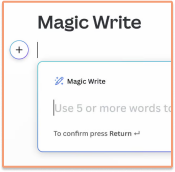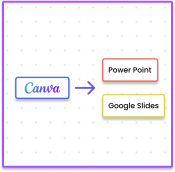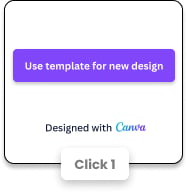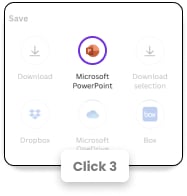We all need some moments of silence in our day to escape the hustle and bustle. It brings calm, helps to re-centre our focus and makes us ready for what’s to come.
That’s no different when it comes to presentation design.
While the visible elements of a slide receive the most focus, the space you leave open — often referred to as whitespace, negative space, or empty space — is equally as important.
As world-famous designer Jan Tschichold once said, “Whitespace is to be regarded as an active element, not a passive background.”
- What is white space?
- What is the purpose of white space?
- Five techniques to improve your use of white space
- Tip #1: Increase the margin
- Tip #2: Use images with “empty” areas
- Tip #3:Leave empty space over a colored background
- Tip #4: Use single words instead of sentences
- Tip #5: Split your content across multiple slides
- The takeaway?
What is white space?
Despite its name, white space isn’t necessarily white.
Instead, ‘white space’ refers to the areas of the slide left unused; any area within a design that is free from text, photos or illustrations and won’t attract the attention of the audience.
It can be any color, texture, pattern or even a background image.

White space is a simple concept, yet many designers — both beginners and pros — find it difficult to apply. The urge to fill a slide’s empty areas is just too great.
One of the biggest mistakes that people make with presentation design is going out of their way to use every millimeter of space on a page — filling the slide with text, boxes, clip art, charts and footers.
But if every element in your slide “yells” for your audience’s attention, nothing gets heard.
The music is not in the notes,
Claude Debussy
but in the silence between.
What is the purpose of white space?
You might be reading this and thinking: what’s the point of white space? If nothing is there, how can it mean anything or add any value?
However, just because it’s empty doesn’t mean it’s wasted — quite the opposite, in fact.
Design theory promotes the use of white space for not only creating a visually appealing product, but for encouraging cognitive engagement within audiences.
Here are a few benefits using white space can bring to your presentation:
- Improved comprehension. Using white space evenly makes the content easily scannable and significantly improves legibility. Studies have shown that this increases reader comprehension by almost 20%.
- Focus and attention. White space funnels the reader’s eye towards the content and allows your message to stand out.
- Helps build hierarchy. White space can signify which parts of the content are most important, making it easier to understand.
- Separates and groups elements. It provides the brain with visual cues as to which elements belong together and which are separate.
- Implies elegance and sophistication. Upscale brands often use ad layouts with little text and a lot of white space. Empty space can convey a feeling of high quality — just think of Apple’s branding.
So, how much white space should you use?
The most important thing to consider should be your content. What message are you trying to put across? How much text and imagery do you need on the page?
If the answer to that question is lots, then using white space to separate this content into small chunks will ensure readers can digest the information. In turn, your overall message will be clearer.
5 techniques to improve your use of white space
Tip #1: Increase the margin
Books and magazines are a great example of this. The margin — the blank area between the text and the edge of the page — makes reading dense copy much easier.
For your presentation, consider making the space between the edge of the screen and the content bigger.

Even when text is densely laid out, larger margins act as an eye-break for the reader, meaning information can be read and processed more easily.
But they’re not just visual, margins can be practical, too. If you plan on providing your audience with a print out of the presentation, leaving space for the reader at the bottom of the page to hold the publication will ensure their fingers don’t cover any of the important stuff.
What’s more, the margin can provide that extra space for audiences to make notes on your presentation if necessary (all good ones, we hope).
Tip #2: Use images with “empty” areas
Images are important for any type of presentation.
They help your audience quickly understand the content and are known to have a faster, longer-lasting impact than words alone.
But don’t just choose any old image to throw in there. Be selective with your choice and use background images that have ample white space within them.

These empty areas can be filled or overlaid with text, shapes or simply left alone, depending on how much copy you already have on the slide.
Tip #3: Leave empty space over a colored background
When used correctly, color can be the difference between a captivating presentation and an underwhelming one.
But with so many to choose from, people tend to choose over-the-top background colors and forget about the clarity of their message.
To ensure your presentation is both visually appealing and informative, choose a solid background color that allows your text to be read easily.

Once you’ve set your background color, use only half of the slide to place your content. This will create lots of empty space around the text and simplify the slide, while still adding an element to capture attention.
Tip #4: Use single words instead of sentences
The human voice is more powerful than the written word.
Don’t tax audiences with the job of listening to you and looking at the same words (which, let’s face it, are never in sync with each other). Rather than acting as your script, each slide should present just a handful of key words to echo what you’re saying.
If you can, use one word (or 2 or 3, but not a whole sentence), in a large, bold text that summarizes the topic you are talking about.

By minimizing the content on the slide, you’ll create lots of empty space while also encouraging audiences to listen to you, meaning you can get the message across and improvise if you need to — after all, who sticks to the script anyway?
Tip #5: Split your content across multiple slides
If you’re really struggling to reduce the content, try separating it into several slides.
Both content and design have their own challenges which should be dealt with individually.

Why worry about where an image will be placed if the message is not correct? Equally, why worry about the way a sentence is phrased if the slide’s design is too cluttered and distracting?
Keep each slide as simple as possible and don’t worry about having too many. Flicking through slides keeps the presentation fluent and structured, so — really — the more the merrier!
The takeaway?
A cluttered design is like a cluttered desk: you can never find what you need.
White space not only organizes and simplifies your design, but it allows audiences to easily digest information and understand your message.
Despite essentially being ‘nothing’, white space is the design element that enables the objects on the slide to exist, and without it, you cannot deliver a clear presentation.
So before you start filling your presentation with words and images, consider the importance of simplicity.
Looking for great examples of white space use?
At SlidesCarnival, we have a huge library of free presentation templates that are professionally designed with layouts that make a good use of white space. All of them are completely free to download, edit, and customize. Take a look!








